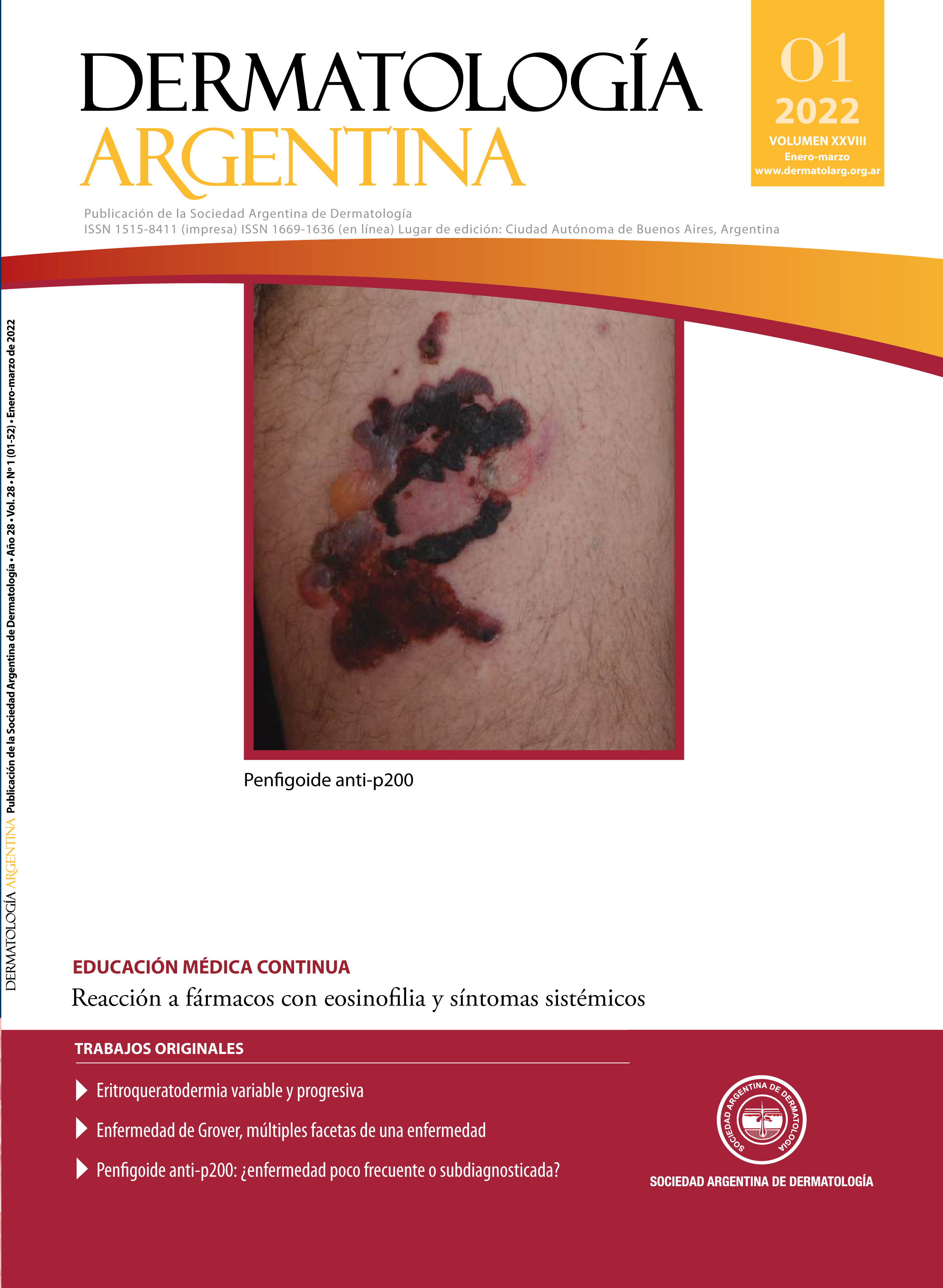Foliaceous pemphigus treated with rituximab
DOI:
https://doi.org/10.47196/da.v28i1.2175Keywords:
pemphigus, pemphigus foliaceus, seborrheic pemphigus, rituximab, anti-CD20 antibodyAbstract
Pemphigus foliaceus is a rare autoimmune blistering disease, affecting mainly middle-aged adults.
Clinically, squamous plaques with seborrheic distribution are observed. The standard treatment is systemic and immunosuppressive corticosteroids, but due to their adverse effects, anti-CD20 antibodies have been used as first-line therapy in recent years. We present a case of pemphigus foliaceus in a young patient, who evolved to exfoliative erythroderma, in which Rituximab was used as a second-line treatment with excellent evolution.
References
I. Di Milia MB, Dickson C, Candiz ME, Forero OL, et ál. Guía de manejo de los pénfigos. Sociedad Argentina de Dermatología 2020;1(1). Disponible en: https://sad.org.ar/wp-content/uploads/2020/06/Guias-de-manejo-de-penfigo-2020.-.pdf. [Consultado diciembre 2020].
II. Abdollahimajd F, Shahidi-Dadras M, Robati R, Dadkhahfar S. Management of pemphigus in COVID-19 pandemic era. Arch Acad Emerg Med. 2020;8: e51.
III. Murrell DF, Peña S, Joly P, Marinovic B, et ál. Diagnosis and management of pemphigus: Recommendations of an international panel of experts. J Am Acad Dermatol. 2018;82:575-585.
IV. Cagnolo SA, Sardoy A, Gubiani ML, Boldrini M P, et ál. Pénfigo foliáceo con desafío terapéutico. Rev Argent Dermatol. 2020;101:106-112.
V. Joly P, Maho-Vaillant M, Prost-Squarcioni C, Hebert V, et ál. First-line rituximab combined with short-term prednisone versus prednisone alone for the treatment of pemphigus (Ritux 3): a prospective, multicentre, parallel-group, open-label randomised trial. Lancet. 2017;389:2031-2040.
VI. Rossello VE, Brusa JR, Andrade MN, Alfaro MF, et ál. Pénfigo vulgar refractario a tratamientos convencionales, con respuesta positiva a rituximab: presentación de 5 casos. Rev Argent Dermatol. 2019;100:15-25.
VII. Saleh MA. A prospective study comparing patients with early and late relapsing pemphigus treated with rituximab. J Am Acad Dermatol. 2018;79:97-103.
VIII. Rashid H, Lamberts A, van Maanen D, Bolling MC, et ál. The effectiveness of rituximab in pemphigus and the benefit of additional maintenance infusions: Daily practice data from a retrospective study. J Am Acad Dermatol. 2020;83:1503-1505.
IX. España A, Ornilla E, Panizo C. Rituximab en dermatología. Actas Dermosifiliogr. 2013;104:380-392.
X. Currimbhoy S, Zhu V, Dominguez AR, Pandya AG. Rituximab in the treatment of 38 patients with pemphigus with long-term follow-up. J Eur Acad Dermatol Venereol. 2016;30:1050-1052.
Downloads
Published
Issue
Section
License
Copyright (c) 2022 Dermatología Argentina

This work is licensed under a Creative Commons Attribution-NonCommercial-NoDerivatives 4.0 International License.
El/los autor/es tranfieren todos los derechos de autor del manuscrito arriba mencionado a Dermatología Argentina en el caso de que el trabajo sea publicado. El/los autor/es declaran que el artículo es original, que no infringe ningún derecho de propiedad intelectual u otros derechos de terceros, que no se encuentra bajo consideración de otra revista y que no ha sido previamente publicado.
Le solicitamos haga click aquí para imprimir, firmar y enviar por correo postal la transferencia de los derechos de autor



















